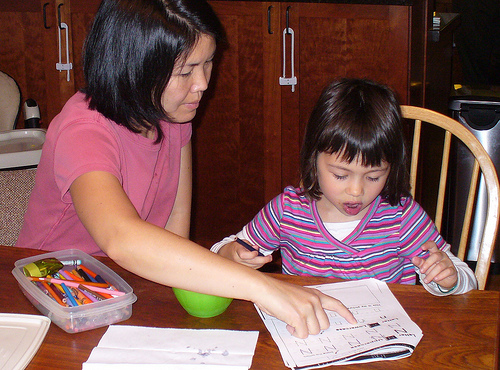Madison, Wisconsin mother Mary Keaveny has enrolled her five children in three different kinds of schools.
The children, ages two to 16, all began learning at home, even the two with dyslexia. Clint, schooled at home until eighth grade, just finished his freshman year at a nearby Catholic school that offers a classical education.
“Clint is a really smart kid, way beyond my ability to school at this point,” Mary said. “He needs to debate and argue, and it’s hard to do that at home.”
Mary knew Clint was in the right place when “we got the greatest letter from one of his teachers, who said he wrote the most beautiful essay for his final.”
Mary is one of thousands across the country who are shepherding their children through a rapidly expanding field of K-12 education options that allow parents to fit education to each child’s changing needs.
Sports and Dyslexia
Thirteen-year-old Ryan Keaveny loves sports. Though always active in various leagues, befriending kids his age was a challenge because Ryan was homeschooled until 2012.
“Playmates would get scarce in the fall as they all went back to their public school sports teams,” Mary said. When the Keavenys moved in 2012, they found a small Catholic school right around the corner.
“Ryan has only 11 [total students] in his class,” Mary reports, “which is great because he now has friends and a teacher who can give him really individualized instruction to help with his dyslexia.”
Dyslexia and Online Learning
Mary has homeschooled Kevin, 10, and Megan, 8, who struggles with severe dyslexia and could barely read.
The family’s recent move, combined with new expenses, Megan’s dyslexia, and the ever-present needs of a two-year-old found Mary needing some accountability for Kevin and Megan.
She found the Hayward Center for Individualized Learning (HACIL) Virtual Charter School, a nonprofit online school chartered through the Wisconsin Department of Education. Because Wisconsin practices public-school open -enrollment, Mary receives a transfer credit of $800 per child to attend HACIL. This can help pay for internet service, books, and even enrichment classes.
Though Hayward is five hours from her home, Mary only has to make the trip when she wants to check out books from HACIL’s library and to present the kids for state testing—a requirement of program enrollment.
“I can homeschool again this year because of the support provided by HACIL,” Mary said, happily.
Pervading Beliefs
Lindsey Hodson of Middletown, Virginia, uses a mix of Montessori, Catholic, and home schools to satisfy the educational needs of her four small children.
“We don’t want our kids riding school a bus—we don’t like the lack of supervision. As Catholics, it’s hard to attend a school that doesn’t follow the liturgical calendar, and we like the fact that Catholic school classrooms all contain a crucifix and kids can pray and say the Pledge of Allegiance,” Lindsey said. “Catholic schools also maintain an ongoing sibling discount, which encourages procreation. They are very open to life.”
Catholic education has not fitted every one of her kids, Lindsey says. Because dyslexia has challenged her husband, Lindsey wants to closely supervise her children’s reading instruction. As with her first child, who starts second grade in fall 2013, she plans to teach her children to read before their first grade.
The Hodsons’ five-year-old son spent a year in Montessori school and will attend one day a week this fall because he learns differently than their other three.
“I need to work on getting this kid to be more of a self-starter like the others,” Lindsey explains.
Crying at School
Lauren Marshall had never considered an alternative to public school until her son, Dillon, came home from school crying one day. Dillon has ADHD and reading difficulties.
“I never thought of myself as an advocate for my kids,” the Tulsa, Oklahoma mother said. “I’d drop them off at school, go to work, and think they were fine.”
Laura took the next day off work to follow Dillon through third grade at his public elementary school. She was horrified to witness him climb under his desk and finally leave his classroom altogether.
Lauren quickly quit her job to educate Dillon and his younger brother, David, using curricula a teacher friend suggested. During the next several months, Dillon was also diagnosed with Asperger’s Syndrome and dyslexia.
Online School to Voucher School
After two years at home, Dillon had improved significantly. Then, Lauren found K12 Online Schools. She loved the format but couldn’t afford the tuition. When K12 became available through the newly formed Oklahoma Virtual Learning Academy (OCVA) charter school several years later, she immediately enrolled both boys. For six weeks, her school district refused to allow her kids to transfer, but it ultimately relented.
After three years in OCVA, Lauren found Oklahoma’s Lindsey Nicole Henry Scholarship program for children with disabilities. That allowed Dillon to start ninth grade at Tulsa’s coveted Town and Country School specifically for children with Asperger’s.
The preparation David received through homeschooling helped him gain seventh-grade entry into Tulsa’s George Washington Carver Middle School, a magnet school where students earn attendance through high academic achievement. Otherwise, David would attend Nathan Hale Junior High, which received an “F” on the state’s annual academic report card.
Lauren is convinced: “If more parents understood the need to be involved, real changes in education could be made.”
Image by sanjoseraginggrannies.

